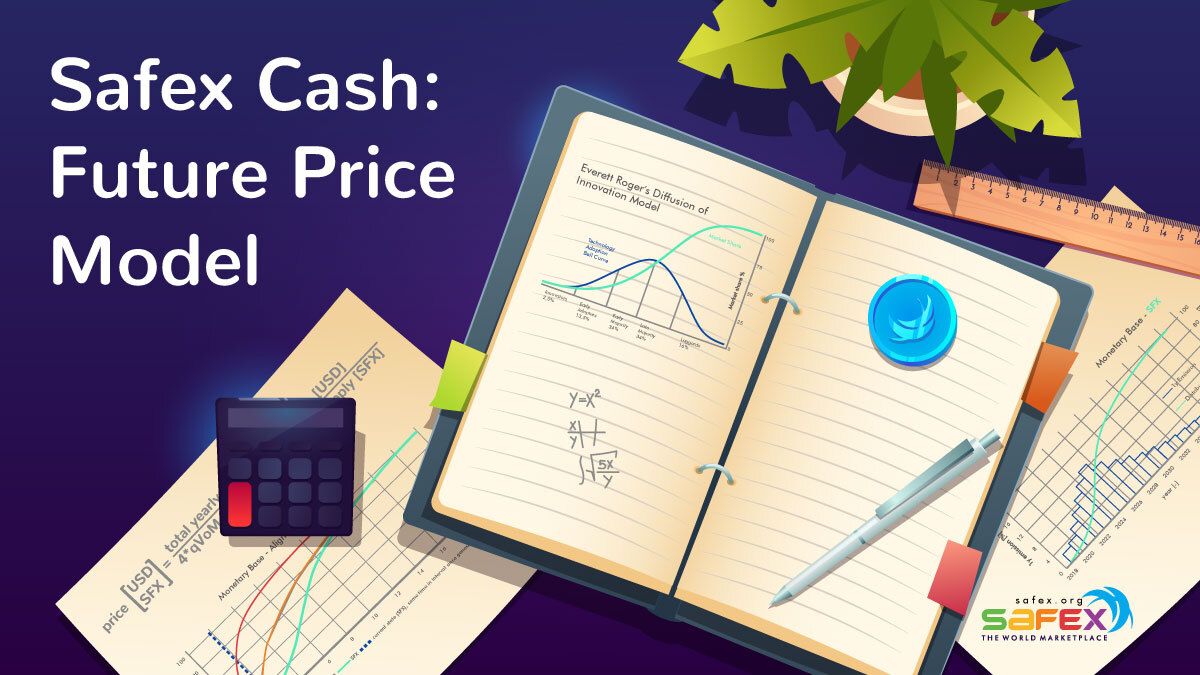Safex Cash Price Model on the Velocity of Money

The future price of Safex Cash is interesting for various types of holders, be it short-term speculators, long-term miners or future users of Safex World Marketplace. Although price action in the cryptocurrency space is majorly driven by hype, a model can help to estimate the future Safex Cash price based on the use of the marketplace protocol.
Note: None of the information contained in the article should be used as financial or investment advice. The figures used as part of the model could differ in reality and should be considered only as part of the example to evaluate the model described here.
Introduction
A simple future price model of Safex Cash (SFX) can be set up based on the following key parameters:
- total yearly transaction volume [USD]
- quarterly velocity of money (qVoM)
- circulating supply of Safex Cash
Since this model will be based on the use of the marketplace protocol, a total yearly on-chain transaction volume on The World Marketplace (TWM) is supposed first - for example: $100m/y. This means that goods and services worth $100,000,000 are exchanged over the Safex protocol within one year.
Quarterly Velocity of Money - a Price defining Key Parameter
The quarterly velocity of money (qVoM) is a parameter describing the cryptocurrency's use as a medium of exchange (MoE). A high velocity of money indicates that the adoption as a MoE is high. A low velocity of money indicates that the cryptocurrency is more used as a store of value (SoV) or not used at all. Theoretically, Safex Cash was designed to become a medium of exchange and to have a high velocity of money in the future but this is not guaranteed. The well-known term "HODL" is not just a meme, it is reality for most of the cryptocurrencies which main use is holding and speculating on a higher price. In order to estimate the future velocity of money of Safex Cash, other cryptocurrencies are analysed regarding this parameter where possible.
The quarterly velocity of money can be calculated based on on-chain metrics and can be described as given below:

An approximation for the quarterly transaction volume can be extrapolated from the average daily transaction number and average transaction value within the last month.

Data from BitInfoCharts is used to approximate the qVoM parameter for the cryptocurrencies Bitcoin, Bitcoin Cash, Litecoin, Zcash and Ethereum.

The data indicates that we can assume a qVoM of 2 - 20 for Safex Cash for evaluating our model. It is important to mention that the data does not differentiate the use of the counted transaction numbers and average transaction values. A significant ratio can be assumed to be transactions from and to exchanges for trading purposes. Another share might be transactions from people moving their holdings to a new cold storage address, etc. It is not possible to determine the different velocities according to their use. With that being said, we likely could set the qVoM parameter in our example model to 10 for all transaction types (trading, moving funds across own addresses, marketplace activity).
Correction Factor f(TWM)
As a result of different uses of the cryptocurrency, it is important to notice that not the entire circulating supply will be available for the use which we are focusing on - medium of exchange on the marketplace protocol level. Therefore, we have to include this factor when building a model that derives the price based on marketplace activity and circulating supply of the currency. The resulting formula

with

takes this circumstance into consideration. The introduced factor describes what ratio of the circulating supply is available for the marketplace protocol. The factor multiplied by the circulating supply is the share of the supply which regularly gets exchanged between buyers and sellers on the protocol level (offer purchase transactions). It can be seen that the factors qVoM and f(TWM) significantly affect the price in this model. As a result, the future price can not be predicted based on an estimated marketplace protocol volume. However, it can be narrowed down to a likely price range and the effects of different qVoMs and f(TWM)s on the price can be quantified. Since the marketplace is not released yet, the introduced factor will likely be on the lower end at release and increase as time goes by and adoption picks up.
Safex Marketplace: Measurable Economic Activity
The Safex Cash is designed to operate on an embedded marketplace protocol directly on the blockchain. The marketplace protocol implements a purchase transaction which is measurable in real time. Therefore, unlike other generic cryptocurrencies, with Safex it is possible to monitor actual economic market activity and reflect that data in the financial market. As a result, it will be possible to quantify the velocity of money of Safex Cash used as a medium of exchange on The World Marketplace in the future.
Likely Price Range based on the Model
As an example, two scenarios show how the price would react as a result:
- low price scenario: high qVoM, high f(TWM)
- high price scenario: low qVoM, low f(TWM)

Conclusion
A likely future price range of Safex Cash can be estimated by using a simple model that does not contain many parameters. The input for the model can partly be guessed based on available data of other cryptocurrencies (qVoM) and partly needs to be provided without other data to compare (marketplace GMV and f(TWM)). Although it is obviously impossible to estimate an exact future price, the model is good enough to give a likely price range based on a specific amount of adoption.
